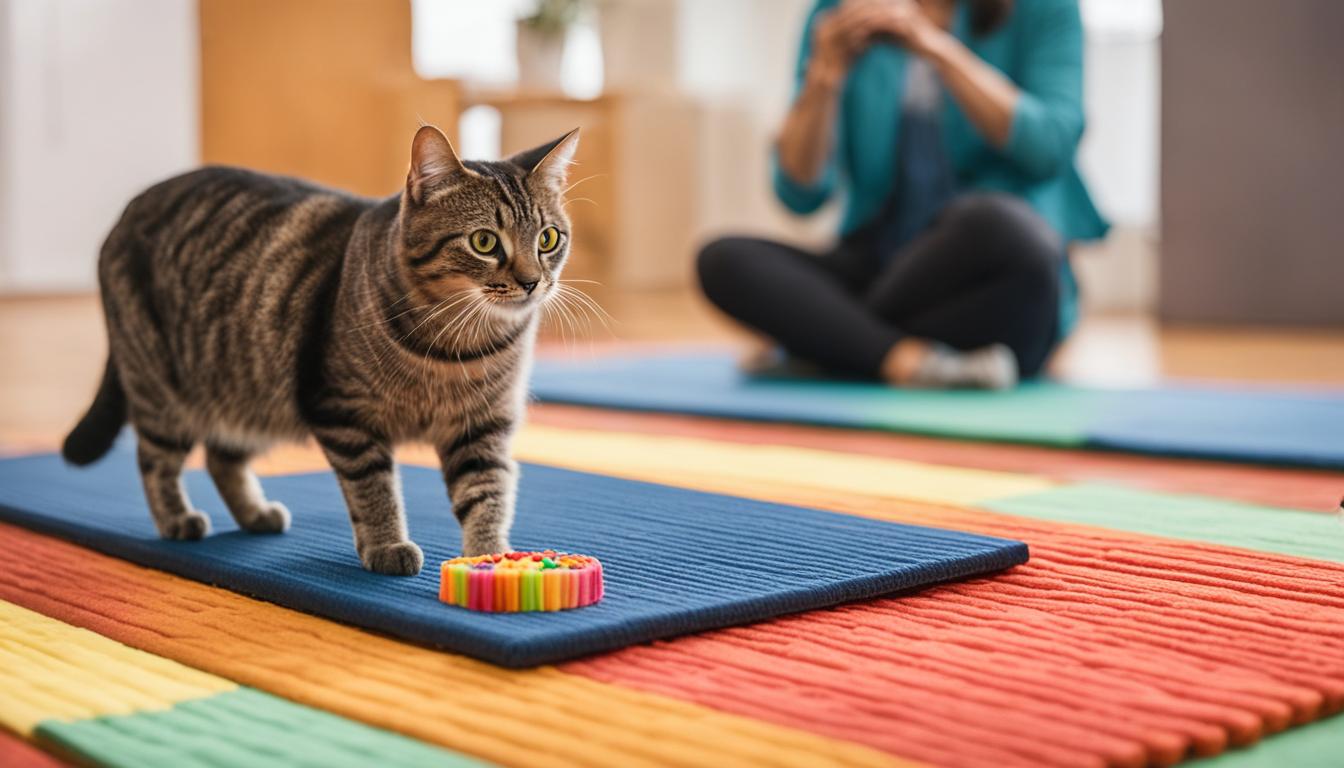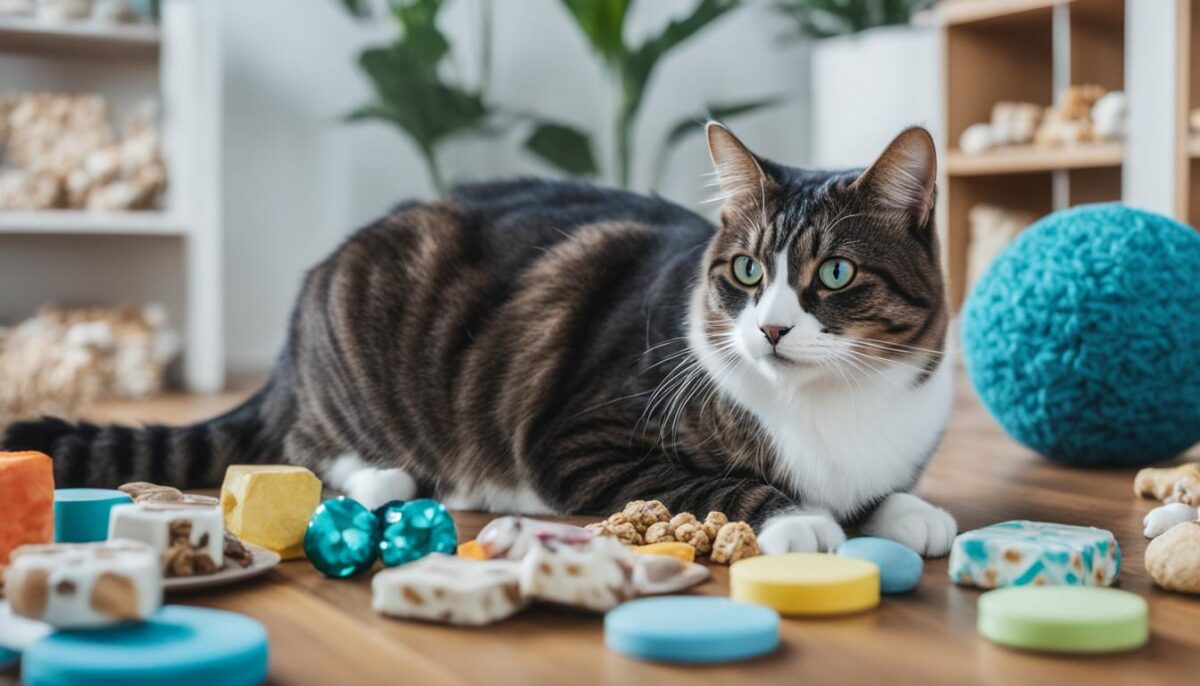Do you think you can train your cat? It’s true! Your fluffy friend can learn cat commands. With treats and a happy voice, you can teach your cat to sit. It’s fun! You’ll need to be patient and keep trying. Cats are smart and can learn feline obedience, but they all learn at different speeds. Try a few times a day for short times. Most cats can learn in a week if you keep at it. Let’s make training a game and have a good time!
Key Takeaways
- Use treats to help your cat learn to sit.
- Keep training fun and positive.
- Short training sessions work best.
- Be patient when you train your cat.
- Celebrate when your cat does it right!
Understanding Your Cat’s Learning Capabilities
Did you know your furry friend can be a trained cat? It’s true! Cat intelligence is often underestimated. Like their canine counterparts, cats can learn commands and perform tricks, such as sitting or lying down. Starting feline training may seem tough, but with the right steps, you’ll see just how smart they are.
It’s all about taking it slow and using positive reinforcement. Each cat learns differently, so while one may pick up on commands quickly, another might need extra love and treats. Patience is key in feline training, and appreciating the process will help both you and your cat enjoy your training sessions more.
- Use tasty treats to grab their attention
- Guide them into sitting with a gentle hand motion
- Always reward with a kind word or a pet for a job well done
- Remember, a session full of play and treats makes learning fun!
Here’s a simple table to show what to look for when assessing your cat’s progress.
| Training Sign | What It Means |
|---|---|
| Quickly Sits on Command | Your cat is grasping the idea! |
| Slow or Unsure Response | Keep practicing, they’re still learning. |
| Ignoring the Command | Try to make training more fun or break it down into smaller steps. |
| Runs Away From Training | They might be feeling stressed or overwhelmed, give them a break. |
Just like in school, practice makes perfect. So, don’t get upset if your cat doesn’t pick up a command right away. They’re smart, and with your guidance, they’ll become the star pupil in no time!
Creating the Perfect Training Environment
To teach your cat new tricks, you need the right spot. It’s like picking the best classroom for learning. Imagine a space just for you and your cat, where you can teach without any noise or other pets running around. It’s all about making a special space that is cat-friendly and cozy.
Finding a Quiet Space
Start with choosing a quiet room. It should be a peaceful place where your cat can pay attention without being disturbed. This room is a zone without loud sounds, where minimize distractions is the goal. With this kind of spot, your kitty can learn the best.
Gathering Your Training Supplies
Once you’ve got a hush-hush spot picked out, it’s time to grab your training tools. Think of it like packing your backpack with the coolest school supplies. You’ll need a quiet clicker for clicker training, which is like raising your hand in class to answer a question – it tells your cat they’re doing great!
- Cat treats
- Clicker
- Toys
- Treat pouch
These treats are super tasty and easy for your cat to eat quickly. Plus, there are stick or liquid snacks if your cat is not really into munching treats. Remember, every time your kitty does what you ask, they get a treat. It’s their little gold star for being amazing. This part of training is called the reward system.
| Tool | Why It Helps | Tip |
|---|---|---|
| Cat Treats | Yummy rewards for good behavior | Choose treats that require minimal chewing |
| Clicker | Signals when your cat is doing things right | Use it right when your cat follows a command |
| Toys | Helps keep training fun and engaging | Switch toys often to prevent boredom |
| Treat Pouch | Keeps snacks handy for quick rewarding | Wear it around your waist for ease of access |
With a calm place and the right set of tools, you’re all set up for a super fun learning time with your cat. They will be sitting and doing high-fives before you know it!
Selecting the Right Incentives for Your Cat
Every cat is unique and finding what makes your kitty purr with excitement is key to effective training. Whether it’s using cat training rewards, tempting treats for cats, or simple play as reward, choosing the right incentives will make all the difference. Here’s how to discover which incentives work best for your feline friend!
- Tasty Treats: These are little bites of food that your cat finds irresistible. Pick treats that your cat can eat quickly and easily.
- Dry kibble
- Soft chews
- Small pieces of chicken or fish
- Fun Playtime: Sometimes, a good play session is all the reward your cat needs. Try using a favorite toy to play with your cat after a successful training.
- Feather wands
- Interactive toys
- Laser pointers (but make sure to finish with a tangible toy so your cat feels a sense of completion)
- Affection: A cuddle, petting session, or kind words can also be used as a reward. Not all cats like the same type of affection, so see what your cat enjoys the most.
- Gentle strokes on the back
- Chin scratches
- Soft spoken praise
Remember, the reward you choose should be given right away to help your cat make the connection between the good behavior and their incentive. This keeps them focused and eager to learn.
| Incentive Type | Description | Examples |
|---|---|---|
| Food Rewards | Small, yummy treats that are easy to eat quickly. | Kibble, chews, bits of chicken |
| Play Rewards | Engage in an interactive game as a form of praise. | Feather wands, ball chasers, laser toys |
| Affection Rewards | Show love with physical touches or kind words. | Strokes, scratches, verbal praise |
Find out what makes your cat happy, and soon you’ll both enjoy the fun of training!
Step-by-Step Training: How to Train a Cat to Sit
Learning to train your cat to sit is fun! Let’s move step by step to help your furry friend learn this cool trick. Remember to be patient and have treats ready.
Introducing the Lure
Start with lure training. Hold a treat in your fingers to get your cat’s attention. Slowly move it above their head, so they have to look up and back. This will help them understand they need to sit to keep their eyes on the treat, using their natural cat behavior.
Mastering the Hand Signal and Verbal Cue
Next, you’ll teach your cat the hand signal and feline verbal cues. Say your chosen word for the cat sit command, like “Sit,” and use a clear hand movement. Do this every time so your cat starts to make the connection.
Reducing Reliance on Treats
As your cat gets better, it’s time for treat reduction. Pretend to have a treat but give the command with only the hand signal. Even when you stop using treats, keep using the reward system by giving lots of praise! This will make sure they still feel great about doing the trick.
| Training Step | Keyword | Goal |
|---|---|---|
| Lure with treat | Lure Training | Get your cat to sit by following the treat. |
| Introduce verbal cue and hand signal | Hand signal, Feline verbal cues | Help your cat connect the cue and action. |
| Reduce and eliminate treat usage | Treat reduction, Reward system | Train your cat to sit without needing a treat. |
Keep practicing, and soon you’ll see your cat sit with just a cue! That’s training progression in action. And remember, the best part is spending time together and learning new things.
Progressive Training Techniques and Tips
When your cat can sit on command, it’s time for the next fun steps! With a little patience in training, you can teach your kitty to sit for longer times and even do this in diverse training environments. This is all part of extended sitting training.
Advancing to Longer Sitting Durations
To help your cat keep sitting for more time, make sure to go slow. Ask them to sit and then wait a little longer each time before giving a treat. Your cat is doing some longer training sessions, so keep things happy and don’t rush.
Training in Various Locations and Distances
Your cat is smart, and they can learn to sit in new places too. Whether it’s the living room or the kitchen, your cat will get to know this skill is for everywhere. You can also try giving the sitting cue from farther away, using distance cues. Let’s keep it versatile training!
| Training Step | Goal | Tips |
|---|---|---|
| Increase Sitting Duration | Longer Sits | Go slow, add a few seconds each time |
| Use Distance Cues | Follow command from further away | Start close, gradually increase distance |
| Change Locations | Sit command works in all rooms | Train in quiet spaces with fewer distractions |
Remember, training should always be fun for both you and your cat. If you notice your kitty getting tired or losing interest, give them a break. With your support, they’ll learn cool new things in no time!
Beyond the Basics: Expanding Your Cat’s Training
After your cat has learned to sit beautifully, you’re both ready for more advanced cat training. This is where you can teach your furry friend some new commands and help them learn cool feline skills. It’s really fun to see how much your cat can do with a little practice. Let’s look at taking your cat’s training expansion to the next level!
Just like when you first taught your cat to sit, learning new tricks will take some patience and lots of yummy treats. Remember, your cat likes to learn in short, happy moments. So keep your training times short and sweet for the best results.
- Get your cat to ‘stay’ by holding your hand up, like a stop sign, after you say ‘sit’. Give them a treat when they don’t move.
- Tell your cat to give you a ‘high-five’. Tap their paw while saying ‘high-five’ and reward them when they lift their paw.
- Teach your cat to ‘shake hands’. Touch their paw and when they move it, say ‘shake’, and give them a treat.
Learning new commands isn’t just fun, it also helps your cat stay sharp and enjoy their time with you. Just think of all the awesome things you and your cat can do together with these new tricks!
Conclusion
Training your fluffy friend how to sit is more than just a cool trick. It’s like teaching them an important skill that helps them learn even more cool stuff. This training is a big win for you and your cat—making your friendship stronger and giving your cat’s brain a good workout. It’s a fun way to spend time together and achieve something awesome.
Remember, the key is to be patient and keep giving those happy ‘good job’ vibes whenever your cat gets it right. If you do this every time, your cat will understand sitting faster. Every little step your cat takes in learning to sit is a big reason to feel proud. So, give a big smile and show some love for your cat’s hard work!
In the end, every moment you and your cat work together is special. Each treat, each ‘sit’, and each playful moment is part of a cool journey. Keep it up, and soon, you’ll see just how smart and amazing your cat can be with a bit of practice and lots of love.
FAQ
Can you really train a cat to sit on command?
Absolutely, you can train your cat to sit on command. Just like with any other pet, it requires patience, the right treats, and consistent positive reinforcement.
What kind of intelligence do cats have when it comes to learning commands?
Cats have their own unique type of intelligence and can learn a variety of commands including sitting, lying down, and responding to their name when trained properly.
How important is the training environment when teaching a cat?
A calm and quiet training environment is key. It should be a space where your cat can focus, free from distractions like loud noises and other pets.
What kind of treats work best for training a cat to sit?
The best treats for training are small, tasty, and require minimal chewing, so they can be consumed quickly during the training session. Lickable treats can also be a good alternative if your cat isn’t highly food-motivated.
How do I use a lure to train my cat to sit?
With a treat in your fingers, gently guide your cat to follow the treat by moving it upwards and away from their nose. This will cause them to naturally sit back to keep their eyes on the reward.
When should I start using hand signals and verbal cues?
Once your cat follows the lure consistently, you can start transitioning to hand signals and a verbal cue word. Over time, your cat will associate these cues with the action of sitting.
How can I train my cat to respond for longer periods of sitting?
Begin by asking your cat to sit for brief periods and then slowly extend the time before giving a reward. Patience is essential, so only increase the duration as your cat becomes more comfortable with the command.
Can training a cat to sit serve as a foundation for other behaviors?
Definitely. Once a cat has mastered the ‘sit’ command, it can be a stepping stone to other behaviors such as ‘stay,’ ‘high-five,’ and ‘shake hands.’
How long should each training session last?
Short sessions, about three minutes long, conducted three times a day, are ideal to maintain your cat’s attention without causing overstimulation or fatigue.
What signs should I look for that indicate my cat is ready to move on to more advanced training?
Behaviors like consistently following commands, showing interest in the training sessions, and being able to perform the ‘sit’ command in various settings are good indicators that your cat is ready for more advanced training.


